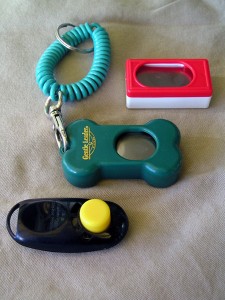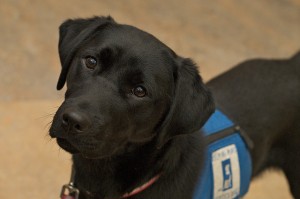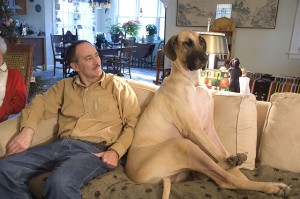Eric Brad begins this year with the basics of clicker training and shows you how to set your dog up to succeed and have fun with training.
I spent most of 2010 on Life As A Human talking about “catching your dog doing the right thing” and “setting your dog up to succeed”. As I looked back over those stories of training successes and pitfalls, it struck me that perhaps it’s time to share some of what we do in our house to teach our dogs.
 We came to our current training methods through clicker training. Clicker training is a training methodology that evolved from work of psychologist B.F. Skinner and was adapted successfully in working with dolphins and other marine mammals in the 1960s. While amazingly effective, positive reinforcement training using a marker (e.g., whistle or clicker) and rewards (usually food) was relatively unknown to the dog training community until Karen Pryor released her book Don’t Shoot The Dog in 1984. Even so, we only discovered clicker training in 2003, and most dog trainers still either haven’t heard of clicker training or don’t understand what it really involves.
We came to our current training methods through clicker training. Clicker training is a training methodology that evolved from work of psychologist B.F. Skinner and was adapted successfully in working with dolphins and other marine mammals in the 1960s. While amazingly effective, positive reinforcement training using a marker (e.g., whistle or clicker) and rewards (usually food) was relatively unknown to the dog training community until Karen Pryor released her book Don’t Shoot The Dog in 1984. Even so, we only discovered clicker training in 2003, and most dog trainers still either haven’t heard of clicker training or don’t understand what it really involves.
The amazing thing to us is that clicker training is as simple as it is effective. So maybe it’s time to share a little of what we’ve learned about clicker training and how we apply it with our dogs.
The process of clicker training itself is as easy as 1-2-3: see the behaviour you want, mark it with a click, and reward your dog for it. See It! Mark It! Pay for It!
The Training Game
In the past, we spent way too much time teaching our dogs by stopping them from doing the things we didn’t want. By process of elimination, anything we didn’t correct must be all right to do; however, after a while, most of our dogs just stopped trying things. Teaching our dogs what we wanted them to do was a completely different experience. To me, it’s almost like playing Charades with my dogs. And how appropriate to make it like a game!
Of course, like Charades, you have to begin by knowing what it is you are trying to communicate. In working with my dog, that means that if I am going to mark a behaviour as “correct”, I’d better know what that is so I can mark it when I see it. For simple behaviour like “Sit”, it’s relatively easy. You just watch for the dog to put their bum on the floor then CLICK! That’s it! Come get your reward.
So to start playing “clicker training” with your dog, you first have to know what to look for so that when you “See It” you can “Mark It”.
Get Clicking!
If you ask a good comedian what the most important thing in comedy is, he’ll probably tell you it’s “timing.” The same is true for good clicker training. Just like a timely touch of the nose in a game of Charades, a timely “click” tells your dog when he or she has done the thing that gets the reward. But let’s step back a minute, how does your dog know that “click” means they get a reward? Well, you show them.
The easiest and best way to do that is to just sit on the floor with some treats. Each time you click, just feed your dog a treat. After a few clicks, hold the treat out in such a way so that when you click, your dog needs to walk over to get it. Dogs are pretty smart when it comes to food. They will learn in no time that “click” means “Come and get it!”
Now that you’ve established your reward signal, it’s time to match it up with the behaviour you’re seeking. This is where your dog learns “cause and effect”. If you are working on “Sit”, your dog will quickly learn that putting his butt on the floor gets you to make the “click” that means “Come and get it!” for the treat.
Most dogs, in a relatively short period of time, start to think that they are making you click and they will start looking for ways to get you to click! And that’s exactly what we want. Let them start looking for all the ways they can do the right behaviour to get their reward.
Pay Off!
Back in the 1940’s and 1950’s, B.F. Skinner worked out that it’s actually the payoff — the food reward — that made his animals perform trained behaviours reliably. The addition of the “click” (or in Skinner’s case, lights or other sounds such as buzzers) just made it easier to be more precise about what behaviour was actually being rewarded. But the pay-off remains critical to making clicker training work.
The reward really gets to motivation. Why should your dog work for you? Learning new things is hard, especially when you don’t share a common language and your teacher doesn’t have four legs, a tail, or a muzzle with which to demonstrate. Yummy treats go a long way to motivate a dog. The yummier the better.
Just the Basics
 So that’s the basics of this amazing method of training — See It! Mark It! Pay for It! It sounds almost too easy to be true. Well, there are lots of people still out there who are willing to try to convince you that it doesn’t work but it’s been working for hundreds of years, even if we didn’t recognize it. Here’s an example: You ask your dog to sit and he does. You say “Good Boy!” and give him a big fuss. What is that other than See it! Mark It! Pay for It!? You saw he did what you asked, you marked it with a “Good boy!” and you paid off with physical affection.
So that’s the basics of this amazing method of training — See It! Mark It! Pay for It! It sounds almost too easy to be true. Well, there are lots of people still out there who are willing to try to convince you that it doesn’t work but it’s been working for hundreds of years, even if we didn’t recognize it. Here’s an example: You ask your dog to sit and he does. You say “Good Boy!” and give him a big fuss. What is that other than See it! Mark It! Pay for It!? You saw he did what you asked, you marked it with a “Good boy!” and you paid off with physical affection.
Really, the process is nothing new. What is new is our recognition and understanding of that communication process. The last 20 years of behavioural science and research about dogs in particular has allowed us to refine this technique and apply it in some fun and fascinating ways. People have taught dogs all kinds of things with clicker training from search and rescue to law enforcement work, from remarkably complex tricks to tracking and scent work, and many other useful everyday behaviours.
More of a Good Thing
So if we’ve been doing this See it! Mark it! Pay for It! thing for years anyway, what’s the big deal with clicker and positive reinforcement training? Well, think of it this way: doctors used to do surgery with knives and pliers instead of with the incredibly precise instruments they use today. What the latest research on behaviour and training methodology does is give us a way to be more efficient and more effective in communicating with our dogs.
One of the main benefits of that improved communication is the lowered frustration and stress for both dog and handler. Training has become FUN! We don’t have to spend an hour at a time working. Instead, we get results fast and the dog enjoys the success and the pay outs. It seems like a win-win for both of you, and it can be, in a big way! I have seen shy dogs blossom into confident dogs and more outgoing dogs become wonderfully creative and playful after even a short time with clicker training. Much of that can be attributed to a better relationship between the dog and his clicker training handler because things are clearer and easier between them.
We’ve been training dogs for centuries. Clicker training offers us a way to be so much better at helping our dogs understand what we want — and we get to do it in a way the dog enjoys. That means less time spent, less frustration for the dog who is trying to figure it out —, and we get to say “YES!” instead of “NO!” all the time.
Just the Beginning
 This is just the tip of the iceberg. See it! Mark it! Pay for It! is the foundation concept and you don’t need a clicker to do it; however, adding a clicker and some other principles and techniques can sharpen your training skills even more. In the coming weeks, we’ll discuss some of the ways clicker training has been applied to teach all kinds of things to all kinds of animals including ferrets, cats, hyenas, horses, and even rhinos!
This is just the tip of the iceberg. See it! Mark it! Pay for It! is the foundation concept and you don’t need a clicker to do it; however, adding a clicker and some other principles and techniques can sharpen your training skills even more. In the coming weeks, we’ll discuss some of the ways clicker training has been applied to teach all kinds of things to all kinds of animals including ferrets, cats, hyenas, horses, and even rhinos!
In the meantime, check out some of the great links I’ve put into the articles and don’t miss Karen Pryor’s Clickertraining.com website. Karen’s site is full of great information from both professional dog trainers and dog owners who use clicker training. There’s an online store where you can buy some great books and supplies for clicker training. There are even links to other wonderful sites with information on clicker training.
There are still a lot of people in the dog world who would like you to believe that clicker training is too easy and too good to be true; that there must be a catch. I encourage you to check it out for yourselves. It’s inexpensive, it can’t “ruin” your dog and, most importantly, it can be fun!
So I’ll leave all that with you until next time. Right now I have two dogs who would just love to go play “clicker training” so I think we’ll go and have some fun for a few minutes. Enjoy your dogs!
Photo & Video Credits
“Clickers” Elf 2004 Google Images
“Service Dog” Pete Markham (pmarkham) 2009 – from Flickr
“Sitting” Peter Gene 2007 – from Flickr
Video – Markkpct 2006 – from Youtube


Another great article, Eric.
Comes at a perfect time…was looking for something short and easy to send to a friend to help her out. And, Voila!! here it is 🙂